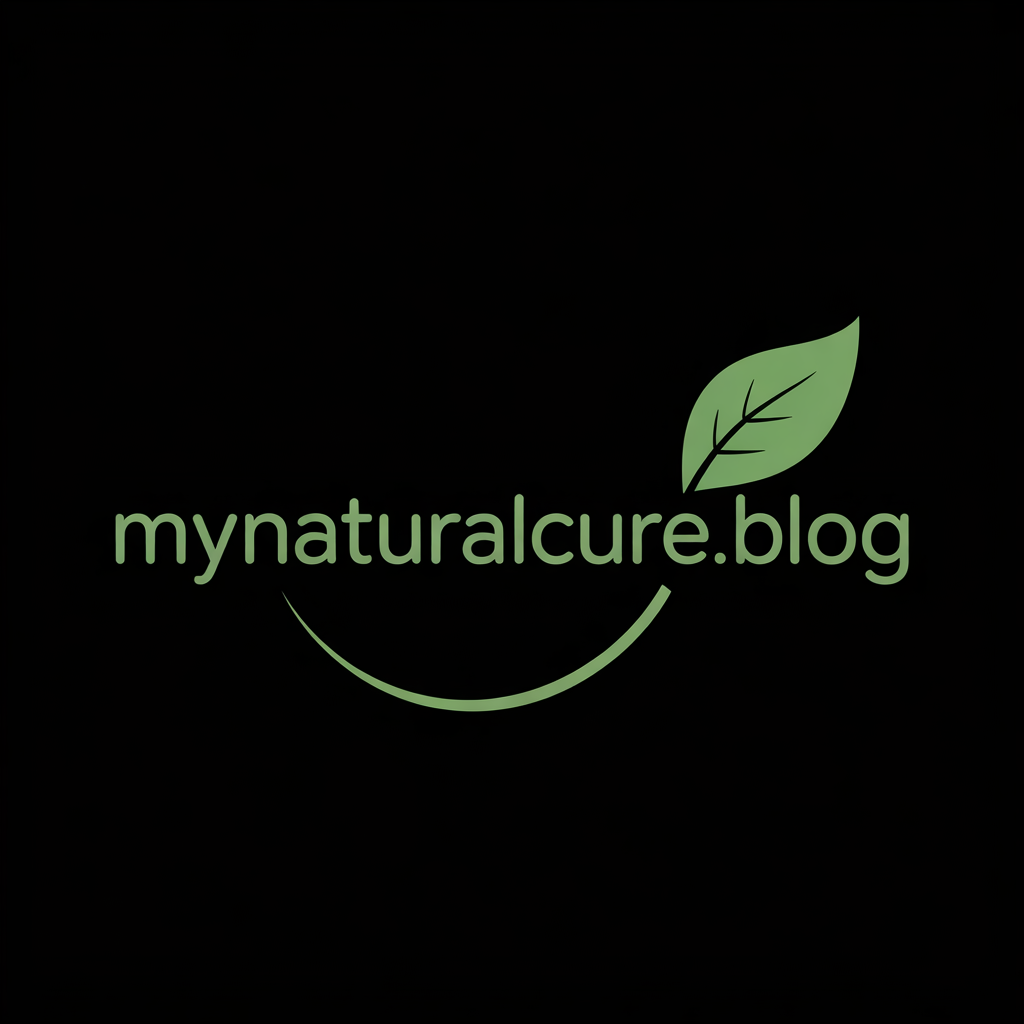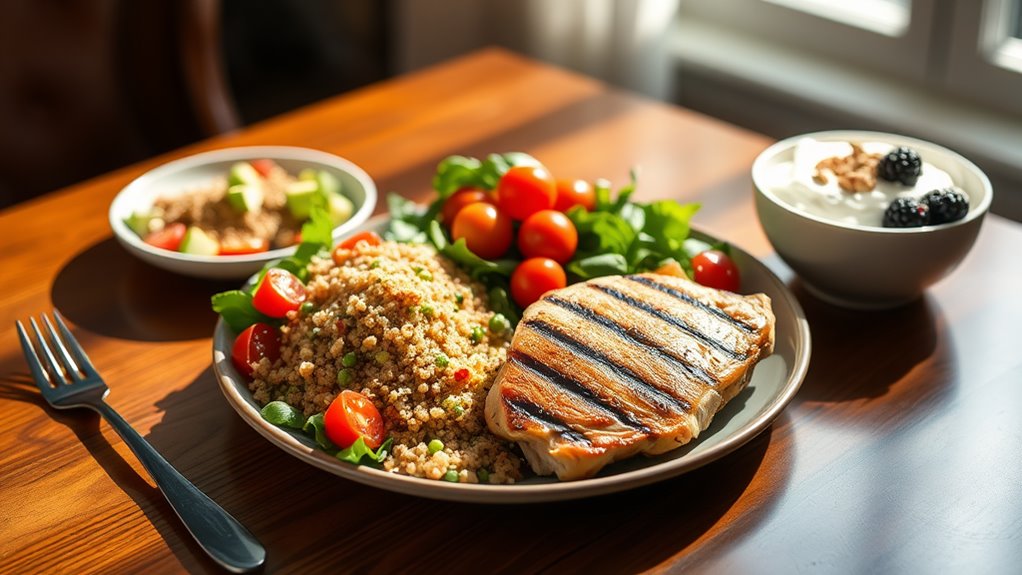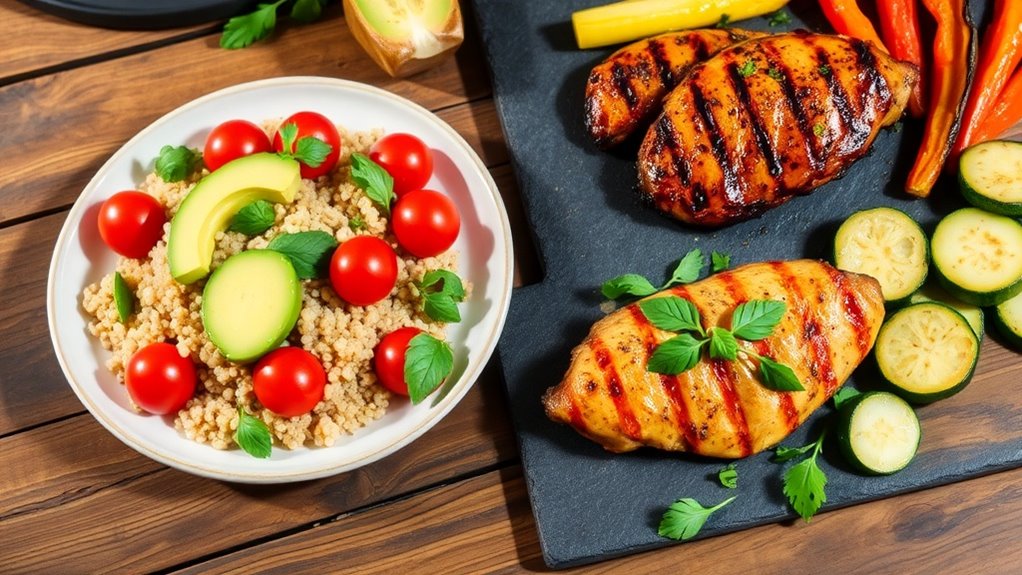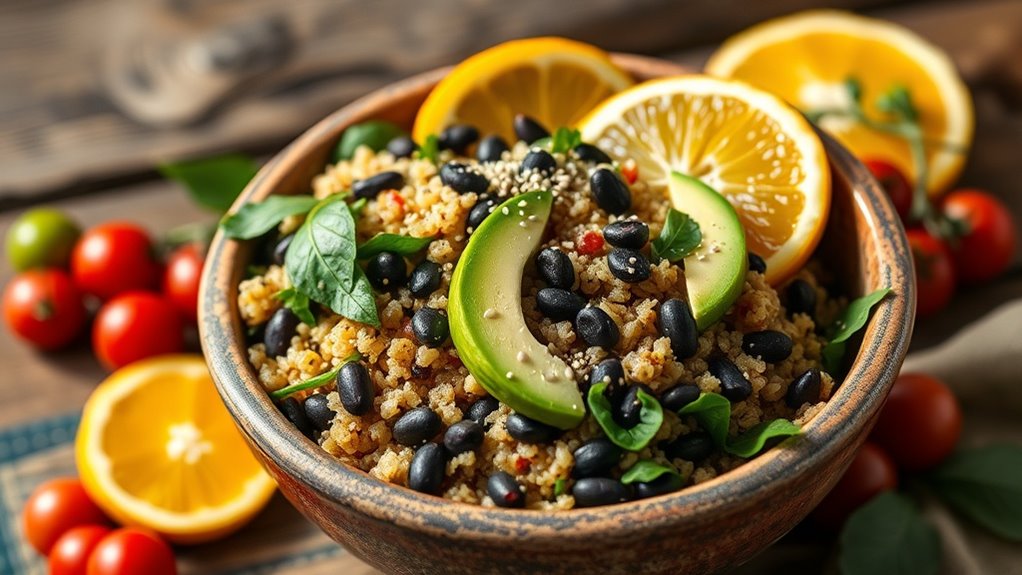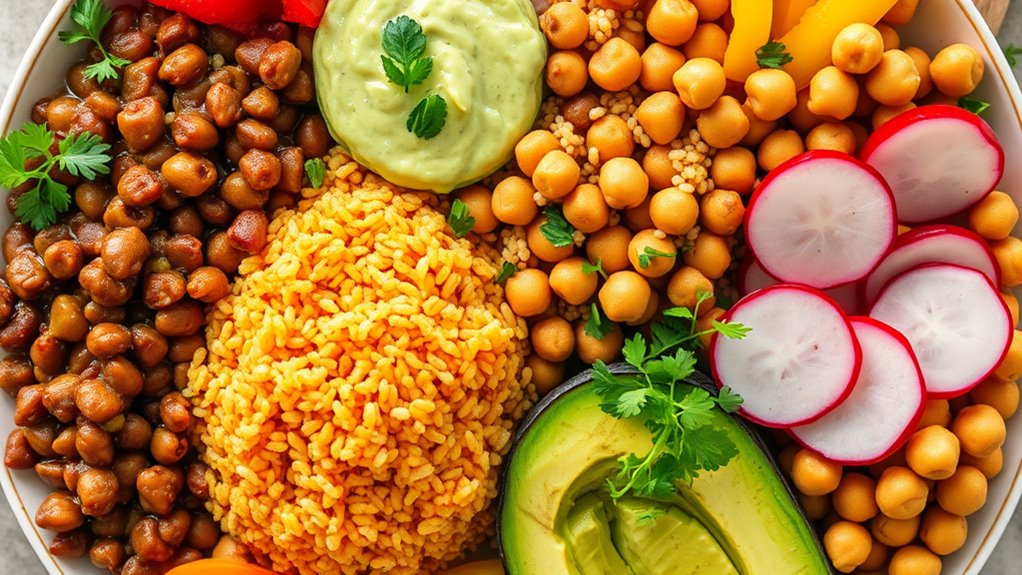Transform Your Meals With These High-Protein Ideas!
Revamp your meals with energizing high-protein recipes that’ll boost your metabolism and support muscle growth. Start your day with a power-packed smoothie or egg-based dish, keep your energy steady with a turkey and avocado wrap for lunch, and enjoy a hearty quinoa chickpea salad at dinner. Snack on handmade protein bars or savory smoothies to keep cravings at bay. You’ll find each bite not only delicious but also packed with health benefits. Exploring these options further could transform your diet.
Key Takeaways
- Incorporate lean meats, fish, and eggs into meals for essential amino acids and nutrients.
- Use legumes, nuts, and seeds to boost plant-based protein intake.
- Prepare smoothies with Greek yogurt, nut butter, or protein powders for a quick protein-rich option.
- Experiment with quinoa and other whole grains as fiber-rich protein bases in meals.
- Opt for cooking methods like steaming and poaching to preserve protein integrity in dishes.
The Benefits of High-Protein Diets
While high-protein diets are often associated with weight loss, their benefits extend far beyond the scale. Embracing a diet high in protein can lead to profound metabolic changes, enhancing not only muscular strength and mass but also aiding in hormone regulation.
This profound shift is what we’ll call protein transformation—a reprogramming of bodily functions due to increased protein intake. It boosts metabolism, contributes to satiety, and diminishes the urge to snack on less wholesome options.
You’ll notice improved energy levels, sharper mental focus, and often, better overall health outcomes. This transformation could be particularly pivotal for those managing chronic conditions like diabetes or metabolic syndrome. Additionally, incorporating tasty high-protein meals into your diet can make this nutritional shift enjoyable and sustainable, ensuring you reap the benefits long-term.
High-Protein Breakfast Options to Start Your Day
Starting your day with a high-protein breakfast can really boost your energy levels. You’ll want to explore energizing egg-based dishes, power-packed smoothie recipes, and quick protein oatmeal fixes. Each option packs a hefty protein punch that can help keep you satisfied and focused until lunch. Additionally, incorporating lean meats like chicken or turkey into your breakfast can increase the meal’s protein content, enhancing muscle repair and growth.
Energizing Egg-Based Dishes
If you’re looking to jumpstart your morning with a high-protein boost, consider the versatile egg, your go-to ingredient for energizing breakfast dishes.
Whether you opt for an omelette loaded with your favorite vegetables and lean meats, or a more sophisticated frittata incorporating fresh herbs and robust cheeses, eggs provide a solid foundation of high-quality protein.
Try poaching eggs and serving them atop whole-grain toast and smashed avocado for a balance of fats and carbs, enhancing your endurance throughout the day.
For those mornings when time is tight, quickly whisk eggs with a dash of milk, pour into muffin tins with spinach and diced bell peppers, and bake. You’ll have protein-packed egg muffins ready for a grab-and-go breakfast.
Power-Packed Smoothie Recipes
After exploring the protein-rich world of egg dishes, let’s turn our attention to another excellent option for a high-protein breakfast: smoothies.
You’ll find smoothies to be a versatile and potent tool in your nutritional arsenal. Begin with a base of Greek yogurt or silken tofu for a creamy texture loaded with protein. Integrate a scoop of your preferred protein powder—whey, pea, or hemp—for an extra boost.
Don’t forget to add fibrous greens like spinach or kale, which enhance the nutrient profile without compromising flavor. For a balanced macronutrient intake, include complex carbohydrates like frozen berries or a banana.
Top it off with chia seeds or nut butter for healthy fats, rounding out a well-balanced, protein-packed meal.
Quick Protein Oatmeal Fixes
While smoothies offer a refreshing way to pack in protein, oatmeal provides a warming and hearty alternative. You can elevate your morning oats into a protein-rich meal with a few savvy additions.
Start by mixing your oats with milk or a plant-based alternative instead of water to boost the protein content. Stir in a scoop of your favorite protein powder after cooking; opt for flavors that complement, like vanilla or almond.
Don’t shy away from adding chia seeds or flaxseeds, which not only increase protein but also add essential omega-3 fatty acids. Top it off with a handful of nuts for crunch and extra protein.
This combination ensures you’re powered up for your day, tastefully blending health with convenience.
Protein-Packed Lunch Ideas for Sustained Energy
When you need to stay energized throughout the afternoon, a protein-packed lunch is your best bet. Here’s how you can elevate your midday meals:
-
Quinoa Salad with Chickpeas and Feta: Blend cooked quinoa, chickpeas, crumbled feta, diced peppers, and spinach. Dress it lightly with olive oil and lemon juice for a refreshing, nutritious meal rich in protein and fiber.
-
Turkey & Avocado Wraps: Use whole-grain tortillas to wrap slices of turkey breast, avocado, lettuce, and tomato. A spread of low-fat Greek yogurt mixed with herbs adds flavor without excess calories while boosting your protein intake.
-
Lentil Soup with Grilled Chicken: Prepare a hearty lentil soup and add chunks of grilled chicken breast. This combination offers a satisfying complexity of textures while ensuring a protein-rich lunch.
Incorporating these high-protein meals into your fitness diet can optimize muscle recovery and growth, aligning your nutritional intake with your body’s needs.
Delicious High-Protein Dinner Recipes
Switching to dinner, you’ll find that incorporating high-protein foods into your evening meals not only satisfies your hunger but also aids in muscle repair and growth overnight. Here’s a focused way to boost your protein intake:
| Recipe | Protein Source |
|---|---|
| Grilled Salmon Fillet | Salmon |
| Beef Stir-fry | Lean Beef Strips |
| Quinoa Chickpea Salad | Quinoa & Chickpeas |
Start by mastering the grilled salmon fillet, a dish rich in omega-3s and about 25 grams of protein per serving. You can also explore a beef stir-fry, which utilizes lean beef strips, offering about 22 grams per serving to support muscle synthesis. For a plant-based option, a quinoa chickpea salad packs over 15 grams of protein. Each dish is crafted to maximize flavor and nutritional value, fitting perfectly into your responsible dietary plan.
Incorporating these meals into your regular diet can help you meet your daily protein needs effectively, ensuring your body receives adequate support for energy and health.
Tasty Protein Snacks for Anytime Cravings
When you’re hungry between meals, why not reach for something that boosts your protein intake? Nutritious portable protein bites are easy to prepare and perfect for on-the-go snacking. Or, you can whip up a creative protein-rich smoothie that satisfies your cravings while providing essential nutrients. For an even simpler option, try making homemade protein bars, which can be customized with your favorite ingredients like nuts, seeds, and dried fruits.
Nutritious Portable Protein Bites
If you’re always on the go but need a quick protein fix, nutritious portable protein bites are an ideal solution.
These compact, easy-to-carry snacks not only satisfy your hunger but also support your fitness goals. Here’s how you can elevate your snack game:
-
Select High-Quality Proteins: Opt for lean sources like whey protein powder, hemp seeds, or finely chopped nuts to pack a powerful protein punch.
-
Balance with Binders: Use natural binders like dates or honey for perfect texture and to add a touch of sweetness without refined sugars.
-
Customize with Superfoods: Mix in ingredients like chia seeds, flaxseeds, or cocoa powder to boost the nutritional value and enhance flavor profiles.
Explore these options and revel in guilt-free, flavorful snacking.
Creative Protein-Rich Smoothies
After exploring the quick and easy delights of nutrient-packed protein bites, another excellent option for fulfilling your protein needs is whipping up creative protein-rich smoothies.
By integrating a variety of proteins like whey, pea, or hemp, you can craft a smoothie that not only satisfies your taste buds but also supports your muscle recovery and growth.
Consider blending Greek yogurt or a scoop of nut butter for a creamy texture, alongside frozen berries or spinach to boost your antioxidant intake.
Opt for unsweetened almond milk or coconut water as your liquid base to keep it light yet flavorful.
Experiment with adding oats or chia seeds for extra fiber and a thicker consistency.
These ingredients transform your usual beverage into a potent protein powerhouse.
Vegetarian Meals With a Protein Punch
While many associate high protein diets with meat-centric dishes, you’ll be pleased to know that vegetarian meals can also pack a substantial protein punch.
Here’s how you can elevate your plant-based eating with high-protein options:
- Incorporate Legumes: Swap in lentils, chickpeas, and black beans. These aren’t only rich in protein but also fiber and iron.
Include them in salads, soups, or as a base for veggie burgers.
- Use Quinoa and Amaranth: Instead of rice, opt for these protein-packed grains.
They offer a complete set of amino acids, essential for muscle repair and growth.
- Add Nuts and Seeds: Sprinkle almonds, chia seeds, or hemp seeds into your dishes.
They boost protein content and add a delightful crunch and texture.
Cooking Tips for Maximizing Protein in Meals
Building on the variety of protein-rich vegetarian options detailed earlier, let’s explore effective cooking techniques that further enhance the protein content of your meals.
You’ll want to focus on methods that preserve and amplify these levels. Cooking legumes and grains at a low temperature for a longer duration can increase their digestibility, allowing your body to absorb more protein.
Opt for steaming or poaching your veggies and proteins instead of frying; this prevents protein loss and maintains nutrient integrity. Incorporate sprouted grains and legumes in your recipes, as sprouting increases the availability of proteins.
Lastly, don’t overcook; excessive heat can denature proteins, reducing their efficacy. By mastering these techniques, you’ll ensure your meals aren’t just delicious but optimally nutritious.
Finding the Best Protein Sources for Your Diet
When you’re choosing the best protein sources for your diet, it’s essential to consider both the quality and variety of options available.
Whether you’re a carnivore, vegetarian, or somewhere in between, diversifying your sources can enhance nutrient intake and prevent dietary boredom.
Here are your top considerations:
- Animal-Based Proteins: Opt for lean meats like chicken or turkey, and don’t overlook fish with its rich omega-3 fatty acids.
Consider the ethical and health impacts of your choices, perhaps selecting grass-fed or wild-caught options.
- Plant-Based Proteins: Incorporate legumes, nuts, and seeds.
They offer fiber and essential nutrients alongside protein, promoting a balanced diet.
- Dairy and Eggs: These are powerhouse options for protein, containing vital amino acids and additional nutrients like vitamin D and calcium.
Integrating High-Protein Foods Into Your Meal Prep
Once you’ve selected your ideal protein sources, integrating them into your meal prep becomes the next step. You’ll want to consider both variety and nutritional balance to maintain your interest and optimize health benefits. Think about complementary proteins across meals, which can enhance amino acid profiles and absorption.
| Day | Protein Source |
|---|---|
| Monday | Grilled Chicken Salad |
| Wednesday | Lentil Soup |
| Friday | Fish Tacos |
Use batch cooking to save time while ensuring that high-protein meals are at the ready. For instance, preparing a large batch of quinoa on Sunday can provide a versatile base for several meals. Focus on pairing these proteins with different spices and seasonal vegetables to keep your dishes exciting and nutrient-dense. This approach enables you to master your diet sustainably and deliciously.
Frequently Asked Questions
How Do High-Protein Diets Affect Kidney Health?
High-protein diets can strain your kidneys if you already have kidney disease. For healthy individuals, there’s less risk, but it’s crucial to balance intake and consult a healthcare professional for personalized advice.
Can High-Protein Meals Help Manage Type 2 Diabetes?
Yes, incorporating high-protein meals can help you manage type 2 diabetes by reducing post-meal blood sugar spikes and increasing satiety. These adjustments may lead to better overall blood sugar control and reduced hunger.
Are High-Protein Diets Safe for Pregnant Women?
You’re balancing cravings with nutrition; however, high-protein diets during pregnancy should be approached with caution. Always consult your doctor to ensure it’s safe and won’t harm your or your baby’s health.
What Are the Risks of High-Protein Diets for Seniors?
You should know high-protein diets for seniors can increase kidney strain and dehydration risk. Also, they might lead to nutrient imbalances affecting bone health. It’s crucial to consult healthcare providers before starting one.
How Do High-Protein Diets Impact Athletic Performance?
Skyrocket your game with a high-protein diet! You’ll enhance muscle recovery and boost stamina. Just don’t forget, balance remains key to avoid overloading your system and undermining your long-term athletic prowess.
